Santa Fe Railroad Tugboats
The Santa Fe Railroad barged rail cars across the San Francisco Bay for much of the 20th century as there is no direct rail link to the San Francisco peninsula. In the post World War II period a fleet of three tugs moved the barges: the Paul P. Hastings, the Edward J. Engel, and the John R. Hayden. After cross-bay float service had ended and the tugs had been sold, the Hastings sank off Point Arena, California in water too deep to raise. The Engel sank off Alameda, California and is expected to be raised. The Hayden remains afloat and in service in Oregon.
Background
The Santa Fe Railroad tracks only went as far west as Oakland, California. (The Southern Pacific Railroad had a line on the San Francisco Peninsula from San Jose, but blocked the Santa Fe from access.) The Santa Fe did have some isolated tracks in the city of San Francisco. To connect to them from Oakland the Santa Fe used a fleet of tugs and barges to move freight across the San Francisco Bay. This service began in 1900 and continued until 1984.
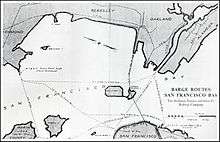
Prior to the end of World War II there were five tugs used on San Francisco Bay at various times:[1]
--- Richmond, built new for the Santa Fe by Fulton Iron Works in 1899. Sold to Crowley Tugboat Company in December 1925.[2]
--- A.H. Payson, built new for the Santa Fe in 1902 by Boole & Sons, Oakland CA. Remained in Santa Fe service its entire life, retired in 1948[2] and was sold for scrap in 1950.
--- E.P. Ripley, built new for the Santa Fe in 1907 by Cruse & Banks, North Bend OR,[2] also sold for scrap in 1950. Ripley was president of the railroad from 1896-1920.
---W.B. Storey, built in Elizabeth, New Jersey, in 1919 as Basford[3] by Bethlehem Steel. Purchased used by the Santa Fe in August 1923.[4] It was used for 25 years, then laid up for parts, the remains sold for scrap in 1966. Storey was president of the railroad from 1920-1933.
--- A.G. Wells, built at Superior, Wisconsin as Hukey in 1919,[3] purchased used by the Santa Fe in September 1925.[4] Commandeered by the U.S. Government in 1943 and not returned.
Post-War additions
--- Edward J. Engel Santa Fe contracted with Consolidated Steel at Newport Beach, CA to construct a new "streamlined" tug. Launched in May 1945 Engle served till the late '60s.[4] Edward J. Engel was the president of the railroad from 1939 to 1944.
During World War II the US Army had many tugboats built. As the war concluded the Santa Fe acquired two of the LT (Large Tug) vessels for use in its cross-bay float service and another was built directly for them. All were named after prominent persons in the railroad:
--- Paul P. Hastings was the VP of Traffic for the railroad at the time of his retirement in 1941. He was the brother of Milo Hastings and grandson of Pardee Butler.
--- John R. Hayden was the assistant to Mr. Engel.
Various cargo was carried by the float service. The railcar barges held fourteen 40-foot (12.2 m) railcars. Some of the railcars were chlorine tankers bound for the water treatment plant. Another cargo was Kessler Whiskey for the Seagram’s facility in South San Francisco. In a famous incident a whiskey tanker was among cars that rolled off the barge in mid-bay during foul weather. Another cargo was box cars of newsprint for the San Francisco Chronicle.
Transportation patterns changed with time. Piggy-back truck service increased as direct railcar service declined. The Chronicle at the urging of the railroad[5] switched to piggy-back truck delivery. As use of the cross-bay float service declined the Santa Fe reduced the tug fleet. The Engel was sold in 1969, and the Hayden was sold in 1976. The Hastings continued as the only tug until 1984. On May 4, 1984 a fire at the Richmond ferry slip killed cross-bay float service, and the Hastings was sold.
All three tugs had steel hulls. All entered service powered by a steam engine driving a single screw. In the mid 1960s the Hastings and Hayden were dieselized, but the Engel never was.
Barge Routes
There were many routes across the bay over the years. At the height of freight ferry operations, Santa Fe tugs and barges called at many slips around the bay. A slip at the foot of Alice St. in Oakland served isolated Santa Fe industrial trackage. Across the Oakland estuary, a slip at the foot of Sherman St. in Alameda, California, where short line Alameda Belt Line (owned half and half by Western Pacific Railroad and the Santa Fe Railroad) received cars from its parent roads. This slip was abandoned around 1970, and thereafter, Southern Pacific Railroad delivered Alameda Belt Line cars via their Fruitvale lift bridge in Oakland. Santa Fe tugs also served the State Belt Railroad's slip at Pier 43 in San Francisco, and the Northwestern Pacific Railroad's slip at Tiburon in Marin County.[6]
The final route for the cross-bay service went from the ferry slip in Richmond, California on the east side of the bay to China Basin on the west side of the bay. China Basin is on the San Francisco Peninsula just south of the San Francisco–Oakland Bay Bridge. The 10.4-mile (16.7 km) voyage usually took about an hour and twenty minutes each way.[7]
Paul P. Hastings Tugboat
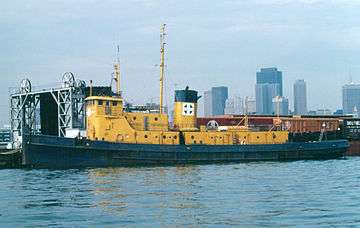
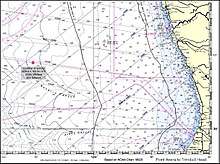
The Paul P. Hastings tugboat was built in 1945 at Point Pleasant, West Virginia by the Marietta Manufacturing Co. as hull number 530 for the US Army. The original name was LT (Large Tug) 814. She had a single screw powered by a three-cylinder Skinner Uniflow steam engine of 1,200 hp (890 kW) served by twin Babcock & Wilcox water tube boilers. Dimensions were 142 ft (43 m) long, 33 ft (10 m) in breadth, 16 ft (4.9 m) deep, gross weight 480 GRT, net weight 68 NRT.[8][9]
On February 11, 1948 she was sold[10] to the Atchison, Topeka & Santa Fe Railroad Co. of San Francisco and renamed A.T.&S.F. No. 8, VIN D256253, Call Sign WD9219. She was later renamed the Paul P. Hastings, in honor of Paul P. Hastings, the vice-president of traffic for the railroad, who died in 1947.
In 1964 the vessel was dieselized at the Todd Shipyard in Alameda, California with a 1,600 hp (1,200 kW) General Motors 567C EMD F-7 engine.
The Hastings had the longest period of service of the three post-war tugs: 36 years from 1948 until the railroad discontinued service in 1984. By the end she was the sole remnant of the tug fleet.
The Hastings was sold and eventually became owned by Robert Whipple of American Navigation (AmNav[11]), a company still doing business in the Bay area. The Abstract of Title shows Levin Metals Corp., a scrap dealer, as an intermediate owner starting at an unspecified date with Whipple taking title on February 26, 1991. The vessel was renamed Terminator. (The first of the Terminator movies came out in 1984.) One source[12] says the tug sat unused for years. In about 1991 Whipple, who had a reputation[13] for added huge amounts of horsepower to old tugs, added two additional 3,600 hp (2,700 kW) diesel engines. The tug was not inspected by the Coast Guard after the engines were added.[14]
The first job for the upgraded tug was to assist the Dock Express 20, a multi-purpose vessel of Dutch registry owned by Dock-Express Shipping B.V,[15] in laying a fiber cable off Point Arena, California. Point Arena is north of San Francisco about 100 miles (160 km) and is the closest point on the west coast of the continental United States to Japan, hence is the landing point for many trans-Pacific cables.
The Terminator became a victim of a marine casualty: she sank. Details of the sinking are found in the US Coast Guard Marine Casualty investigation MC93011836 and Marine Violation investigation MV92003258.
Late in the day of Monday, January 27, 1992, the vessels were about 20 nautical miles (37 km) off the coast of California just north of Point Arena at N39°9.0', W124°10.5'. The weather was ugly: swell height was 15 feet (4.6 m) and increasing, wind speed was 35 knots (65 km/h). Trouble started when a two-inch cable parted at the Sampson braid and the Terminator had to approach the Dock Express 20. It was now a little after 6 pm in deepening twilight (sunset was 5:31 pm).
Shortly after completing her approach to 100–150 feet (30–50 m) abeam of the Dock Express 20, Terminator lost the use of the center engine. The operator attempted to use the port and starboard engines in a twisting fashion to maneuver the vessel out of danger. Then the starboard engine tripped off-line leaving the Terminator with only one of three engines operating. Attempts to restart the starboard engine failed. The high seas were abeam (perpendicular) to the vessel and pushed her into the protruding sponson (a structure on the side of the ship) of the Dock Express 20, who was restricted in her ability to maneuver as a result of her cable laying operation and because of its size was much less affected by the seas. When the vessels collided the Terminator was coming down off the crest of a swell, while the Dock Express 20 was surging upwards from another wave.
The impact created a hole, estimated at 1 to 2 feet (0.3 to 0.6 m) in diameter, in the Terminator’s aft lazarette area (a storage space between decks). The incoming water flooded the shaft alley. The watertight door between the shaft alley and main engine compartment was permanently affixed open. A cutting torch was needed before the door could be secured. This process took 20 minutes and only slowed the water coming into the engine room. Pumps to de-water the vessel operated only intermittently. There was no eductor (a type of water pump). The aft peak tank and bilge were filled with concrete (presumably for stability) and this extra weight could not be shifted to another area of the vessel from where the vessel was taking on water.
With the ship starting to sink the order to abandon ship was given about an hour after the collision. After 15 minutes only the bow was visible and after another 10 minutes the vessel was completely underwater. All crew members entered the life raft and were picked up an hour later by the Craig Foss, a nearby tug which was diverted to assist. The Terminator sank in 800 fathoms (1,500 m) (almost a mile down), and there she remains.
About 35,000 US gallons (130,000 L) of diesel fuel on board spilled creating a light sheen in the vicinity which dissipated in a few days without cleanup. The vessel owner, Whipple, was fined $2100 for the oil spill.
So after having been spared from being scrapped, the Hastings sank.
Edward J. Engel Tugboat
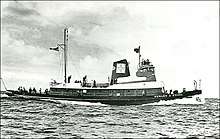
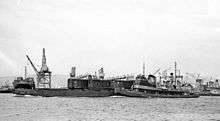
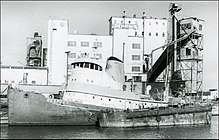
The Engel was built in 1945 for the Atchison, Topeka and Santa Fe Railway Company by Consolidated Steel Corporation as hull number 1320. The business address of the builder was Newport Beach, California. Their shipyard was in the Port of Long Beach in Wilmington, California built in 1941, at what is now berth 196 and 197 of the automobile terminal. The builder dissolved in 1952.
The Engel had a single screw and a steel hull of dimensions 141.5×29×12.7 ft (43.1×8.8×3.9 m). She was powered by a three-cylinder Skinner Uniflow steam engine, 25 x 20, 1,200 ihp (890 kW); Babcock & Wilcox water tube boiler, 3,311 sq ft (307.6 m2) heating surface, 236 psi (1.63 MPa) working pressure.[8] She retains this power plant to this day. Her sister tugs were built with steam and later dieselized. VIN number is 248085.
On September 30, 1969 with barge traffic declining as piggy-back truck usage increased, the Santa Fe sold[10] the Engel to John K. Seaborn, a collector of old tugs and ferries. The sale was not recorded until June 25, 1971. On September 18, 1975 the vessel was removed from documentation because the name was changed to Respect without the consent of the Documentation Officer at the vessel’s home port who at that time had no record of the whereabouts of the vessel or owner.
The next entry in the Abstract of Title for the Engel is on February 24, 2006 when Seaborn sold the vessel to Sause Marine Services, Inc.[16] in the person of Gary Sause. Sause intended[17] to dieselize the vessel whose hull was still in good condition. When Sause received an unsolicited bid for the vessel from Jeff Barnell he accepted it. What Barnell intended to do with the vessel is unknown. In any case he soon sold it to Ron Cook of British Columbia. The Engel/Respect had now changed hands three times in a little over a year. Cook planned to move the vessel to Seattle and restore it. There had been other attempts to restore and preserve the Engel. The Newport Harbor Nautical Museum,[18] near where the tug was built, was contacted but showed no interest. There are several references in Trainorders.COM[19] in the fall of 2006 about saving the Engel.
For many years the Engel had been anchored in the Oakland estuary in Oakland, California just north of the Park Street bridge. The tug was vandalized on April 9, 2007 and sank the next day.[20] Apparently the seacock valve and other metal parts were scavenged for their scrap value. As of February 2008 she remains submerged in the estuary. The location was marked with buoys and a flashing light. The Army Corps of Engineers is now responsible for administering the fate of the Engel. Information provided in a flyer from the County of Alameda indicates, as of October 2013, the USEPA is funding the raising and removal of the Tug Engle (Respect) from the estuary, presently underway. On December 20, 2013, he was raised and removed from her sunken location where she impeded a navigable waterway. Her last transit out the estuary was attached to the bow of the DB GENERAL pushed by the TUG FAT CAT. Media reports she will be located at Bay Ship for removal of hazardous material prior to disposition of the vessel. Whether the Engel will be scrapped or preserved is unknown.
John R. Hayden tugboat
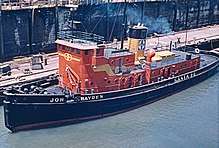
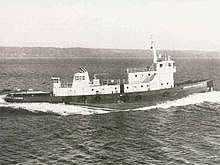
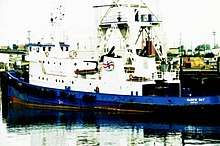
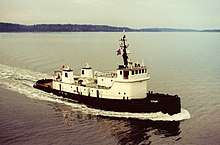
The John R. Hayden is the only tug of the Santa Fe post World War II tug fleet that remains afloat. She was built in 1945 by the U.S. War Department and is now the Titan owned by Sause Bros. and operating out of Coos Bay, Oregon. She had several other owners and names. She was repowered three times. The VI number (VIN) of the tug is 253495, IMO Number is 8424123.
The Hayden was built in 1945, the final year of World War II, by Tampa Marine Corp. in Tampa, Florida as hull number 40 and designated LT-830 (LT for Large Tug). Dimensions were 142.2 ft (43.3 m) × 33 ft (10 m) × 16 ft (4.9 m), tonnage 581 gt, 35 nt.[8] She had a single screw.
On June 5, 1947, she was sold[10] to the Atchison, Topeka and Santa Fe Railway who renamed her the John R. Hayden. When built the vessel was powered by a three-cylinder Skinner Uniflow steam engine, 24.5 × 20", 1,200 ihp (890 kW), supplied by two Foster-Wheeler water tube boilers, 5,460 sq ft (507 m2) heating surface, 225 psi (1.55 MPa) working pressure. In 1967 the Santa Fe had her dieselized at the Todd Shipyard in Alameda, California with a 1,600 hp (1,200 kW) General Motors 567C EMD F-7 engine. In December, 1975 the Hayden was taken out of service due to persistent stern tube leakage.[21]
On September 16, 1976, with barge traffic in decline, the Santa Fe sold the Hayden to Marine Leasing Corp. Marine Leasing repowered the tug, which required rebuilding the superstructure. On December 22, 1983, Marine Leasing renamed the vessel the Marine Crusader. Her home port was then Seattle, Washington.
The repowering of the Marine Crusader was done by Propulsion Systems Inc. of Kent, Washington. The repowered tug put to sea in December 1983 as one of the most highly computerized and automated tugs in the world. It also represented the most complete installation to date of a ship control and monitoring system. The new engines consisted of four General Motors Detroit Diesel 16-cylinder, 1600 hp 149T1 diesel engines with a pair of twin-shaft input/single-shaft output Lufkin reduction gears with controllable-pitch propellers. The control system provided automatic engine load control, multiple engine load sharing, pitch control, machinery monitoring, and steering. The control complex involved two electrically isolated units, port and starboard. Machinery control function was divided between the units, each managing its own propulsion subsystem consisting of two engines, reduction gears with clutches and hydraulics for controllable-pitch propeller. There was an automatic pilot function driven by either gyrocompass or magnetic compass as the input heading source. There were four control station in the tug: main bridge, wing stations port and starboard, and an aft control station. All control systems operated off a non-interruptible power system.[22]
As rebuilt, the Marine Crusader had a beam of 33 feet (10 m). A new epoxy coating was applied to the hull. She had quarters for an operating crew of eight. She had a gym in the forecastle, a useful accoutrement on long, ocean tow missions. With full tanks the Marine Crusader carried 225,000 gallons of fuel.[23]
On November 26, 1984 Marine Crusader was sold to Alaska Marine Towing Inc. On February 5, 1985 Marine Leasing changed her name to Harris Bay, after a bay in the Kenai peninsula south of Anchorage, Alaska. Alaska Marine ran into financial difficulties and filed for bankruptcy. As part of an August 3, 1988 reorganization the new legal owner of the Harris Bay became United Marine Tug and Barge. On August 29, 1988 they changed her name back to Marine Crusader.
Two years later on July 27, 1990 the tug was sold yet again to its current owner Sause Bros. Ocean Towing[24] of Portland, Oregon. Sause Bros. soon gave the tug her current name, Titan and repowered her with two 12-cylinder turbo EMD engines, with 3½ to 1 Lufkin gears.
Sause has since removed the TITAN from service and maintained her laid up in Coos Bay after removing the EMD engines they had installed previously rather than choosing to rebuild them. After determining it would not be cost-effective to repower a 70-year-old hull the decision was made to dispose of the TITAN.
References
- List of pre-war tugs from Valley Division Vignettes, Krieger and Icanberry, 1983
- Santa Fe Valuation Records-Account 56, Floating Equipment, Live List, July 1, 1916 – December 31, 1927, Scholtz Collection, Temple Railroad & Heritage Museum
- "Tugs". Shipbuilding History. Retrieved 30 January 2017.
- Santa Fe Valuation Records-Account 56, Floating Equipment, Live List, Jan 1, 1928 to __, Scholtz Collection, Temple Railroad & Heritage Museum
- Per Riff on Trainorders.COM July 2, 2005
- Routing history from Evan Werkema, an active Trainorder.COM member
- Transit details from the caption to the March page of the 1991 McMillan Publications Santa Fe Railroad Calendar
- Original power plant description from William Lafferty, Wright State University
- "CGMIX Validation Error". psix.uscg.mil.
- Ownership and name changes from the Abstract of Title
- "AmNav Maritime Corporation". AmNav Maritime Corporation.
- Captain Myron Balchin Sr. of San Diego CA
- Per Lance Romance in Yahoo Tugboats Group, Dec 19, 2007
- So stated in the Marine Causality Report
- Dock-Express is now part of http://www.dockwise.com/ Dockwise
- See Sause Marine Services
- Details of this phase of the Engel's history are from Gary Sause
- See Newport Harbor Nautical Museum
- See Trainorder.COM
- Details of the sinking were reported in the Alameda Sun, May 11, 2007
- See Valley Division Vignettes, Krieger and Icanberry, p. 27
- Repowering details from Daily Journal of Commerce, Seattle, Washington, March 2, 1984
- Many more details on the Marine Crusader are contained in The Work Boat, July 1984, pp. 28, 29, 35
- See Sause Bros. Ocean Towing
Bibliography
- Krieger, Jack L.; Icanberry, Glen (1983). Valley Division Vignettes. Valley Rail Press, Hanford, CA.
External links
- United States Coast Guard Port State Information eXchange (PSIX) System Lists many vessels and shows marine incidents.
- ABS Record Shows specifications and ownership history of some vessels.
- United States Coast Guard National Vessel Documentation Center Provides Archive of Title which shows ownership and name changes.